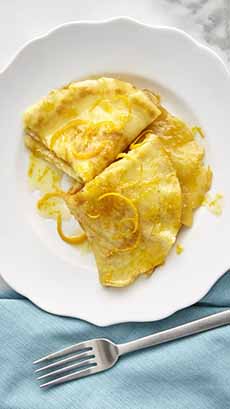What Are Bavarian Crêpes, For National Bavarian Crêpes Day
|
March 22nd is National Bavarian Crêpes Day. What are Bavarian crêpes? Called palatschinke in Bavaria (the singular is palacinka), these crêpes (some people call them pancakes, but see the next section) are typically made from wheat flour or buckwheat flour. You’ll also see them referred to as Balkan-style crêpes, Croatian crêpes, Hungarian crêpes, Serbian crêpes, etc. The cooked crêpe leaves the pan, is filled, rolled, and then often garnished—with powdered sugar, fresh fruit or fruit sauce, chocolate sauce, whipped cream, or a combination. What’s the filling? It can be as simple as jams or cinnamon and sugar. Some crêpes aren’t even filled. They rely on a sweet or savory topping for their flavor. Our Nana’s favorite filling was sweetened ricotta with dash of vanilla—a more elegant version of blintzes. > The different types of pancakes. Both crêpes and pancakes can be served as a savory or a sweet dish. Here are their differences. 1. Batter. Both include flour, egg, milk, and a dash of salt (some crêpe recipes add sugar). But crêpe batter has more eggs and less flour, creating a much more runny batter. Thus, when the batter is poured into the pan, it spreads out more—creating its signature wafer-thinness—about a millimeter. Crêpes are delicate, pancakes are sturdy. 2. Size. Crêpes are large in diameter to allow for filling and rolling. Crêpe pans range from 7.5 inches up to 16 inches in diameter, with 10 to 12 inches the most common size. 3. Leavening. The difference between pancakes and crêpes is that pancake batter includes baking powder or baking soda as a raising agent, while crêpe batter does not. The result is that pancakes rise to their thick and fluffy form, while crêpes remain thin and flat. 4. Resting batter. Unlike a French crêpe, the Bavarian crêpe batter doesn’t need to rest before using. Why does the batter need to rest? For the texture. Resting the batter allows the flour to fully absorb the milk (or other liquid), and gives the gluten a chance to relax. Relaxed gluten produces more tender, melt-in-your-mouth crêpes. One reason the original Bavarian crêpe-makers may have skipped this step: The batter needs to stand at room temperature for 30 minutes. A Bavarian crêpe/palacinka is a crêpe-like thin pancake common in Central and Eastern Europe, rather than a true crêpe. The main difference between Bavarian and French crêpe is that the batter is used right away, rather than letting it rest before using. Rested batter produces a thinner result. |
|
|
|
CHECK OUT WHAT’S HAPPENING ON OUR HOME PAGE, THENIBBLE.COM.
|
||





